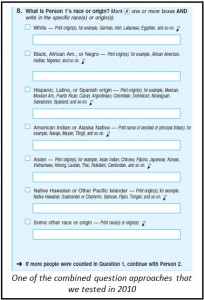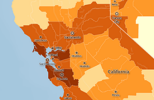The year 2020 may seem a long way away, but we’re already in full swing preparing for the next decennial census. Today, we held an operations update to announce some of the steps we’re taking to ensure that the 2020 Census provides the highest-quality statistics about our nation’s increasingly changing population, such as how we measure race and ethnicity.
One challenge we face is how Americans view race and ethnicity differently than in decades past. In our diverse society, a growing number of people find the current race and ethnic categories confusing, or they wish to see their own specific group reflected on the census. The Census Bureau remains committed to researching approaches that more accurately measure and reflect how people self-identify their race and ethnic origin.
During the 2010 Census, most households received a census form that asked about race and Hispanic origin through two separate questions. However, we also conducted a major research project – called the “2010 Census Race and Hispanic Origin Alternative Questionnaire Experiment” (AQE) – to better understand how and why people identify themselves in different ways and in different contexts.
The AQE tested different questionnaire strategies with four goals in mind:
- Increase reporting in the race and ethnic categories as defined by the U.S. Office of Management and Budget,
- Increase responses to the race and ethnicity question(s),
- Increase the accuracy and reliability of the results, and
- Elicit detailed responses for all racial and ethnic communities (e.g., Chinese, Mexican, Jamaican, Lebanese, etc.).
The results of the AQE supported all of these objectives. One of our experimental approaches asked about race and Hispanic origin in one combined question. In the combined question, each major racial and ethnic group had a checkbox with examples and a write-in line where respondents could provide detailed responses. Many individuals across communities liked the combined question approach. They felt it presented equity to the different categories.
Some of our findings from this experiment include:
- Combining race and ethnicity into one question did not reduce the proportion of Hispanics, Blacks, Asians, American Indians and Alaska Natives, or Native Hawaiians and Other Pacific Islanders.
- The combined question yielded higher response rates.
- The combined question increased reporting of detailed responses for most groups, but decreased reporting for others.
- The combined question more accurately reflects self-identity.
You can check out the AQE website for more information on our findings, and to see what the AQE questions look like.
The AQE’s results led to some promising strategies to address the challenges and complexities of race and Hispanic origin measurement and reporting. We have a lot to consider as we make decisions for the 2020 Census. In order to make the best decisions possible, we are embarking on mid-decade research with both the combined question and separate questions approach. We’re also engaging in an ongoing discussion about race and ethnicity among statistical agencies and various population stakeholder groups. Together, these discussions and research will enable us to provide the most accurate, reliable, and relevant data possible about our changing and diversifying nation.
Over the next few weeks, I’ll blog about additional topics that we addressed at that event.



















